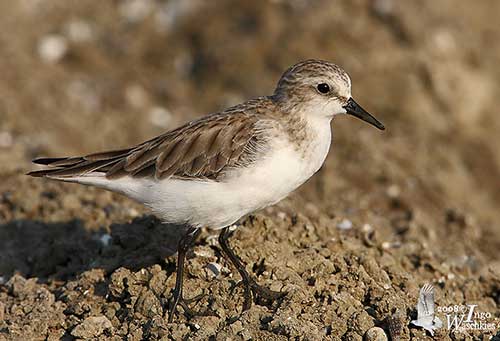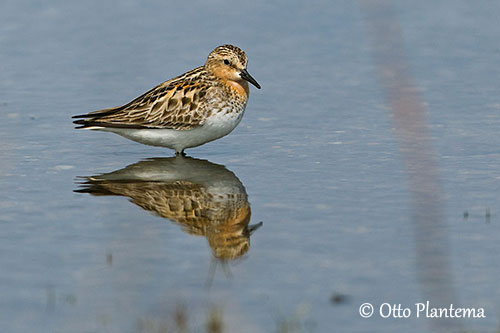
Fr: Bécasseau à col roux
Ang: Red-necked Stint
All: Rotkehl-Strandläufer
Esp: Correlimos Cuellirrojo
Ita: Gambecchio collorosso
Nd: Roodkeelstrandloper
Sd: rödhalsad snäppa
Photographers:
Patrick Ingremeau
TAMANDUA
Otto Plantema
Trips around the world
Ingo Waschkies
Bird Photography
Text by Nicole Bouglouan
Sources:
HANDBOOK OF THE BIRDS OF THE WORLD Vol 3 by Josep del Hoyo-Andrew Elliott-Jordi Sargatal - Lynx Edicions - ISBN: 8487334202
GUIDE DES LIMICOLES de D. Taylor - Delachaux et Niestlé - ISBN : 2603014080
SHOREBIRDS by Peter Hayman, John Marchant and Tony Prater – Christopher Helm – 1986 – ISBN: 0747014035
A Field Guide to the Birds of South-East Asia by Craig Robson. New Holland Publishers. ISBN: 9781780090498
Avibase (Denis Lepage)
Birdlife International
HBW Alive
Birdlife Australia - Red-necked Stint
What Bird-The ultimate Bird Guide (Mitchell Waite)
Red-necked Stint
Calidris ruficollis
Charadriiformes Order – Scolopacidae Family
INTRODUCTION:
The Red-necked Stint is a very small sandpiper. It is mostly an Asian species, although small numbers breed in W Alaska in summer after crossing the Bering Strait.
It frequents the tundra in summer, whereas outside breeding season, it is mostly found in coastal areas such as mudflats, bays and lagoons, and in a variety of wetlands. It feeds mainly on insects and crustaceans, small molluscs and worms. This species is monogamous and nests on the ground, often in small, loose groups.
The Red-necked Stint is migratory. It breeds in NE Siberia and N and W Alaska, and it spends the winter in Australia, New Zealand, SE Asia and S China.
It is threatened by habitat loss at stopover sites during migration, especially in the Yellow Sea where human developments involve degradation of intertidal habitats. The Red-necked Stint is currently classified as Near Threatened.

DESCRIPTION OF THE BIRD:
Biometrics:
Length: 13-16 cm
Wingspan: 29-33 cm
Weight: 18-50 g
The Red-necked Stint in breeding plumage has chestnut face, throat and upper breast, whereas crown and upperparts show chestnut, black and white markings. On the upperwing, the wing-coverts are brownish-grey. The tertials are grey-brown with white or pale rufous edges. We can see a white wingbar (mostly visible in flight) formed by the tips of greater coverts and bases of inner primaries. Central rump, uppertail-coverts and tail are dark brown.
The underparts are white with some dark brown spotting on breast sides below the chestnut colour.
On the head, the crown is streaked dark brown and the lores are blackish. There is a whitish area around the base of the bill and on the chin. We can see a pale supercilium above and behind the eye.
The thick bill is black. The eyes are dark brown. Legs and feet are blackish with unwebbed toes.
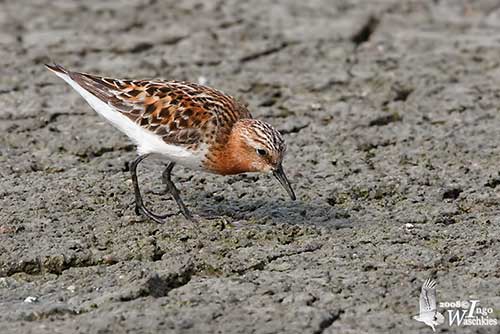
The Red-necked Stint in non-breeding plumage is mainly grey-brown above and white below, with some greyish streaks on breast sides. The white supercilium is conspicuous.
Male and female have similar plumage, but the female has slightly larger wings and bill.

The juvenile has buff and grey back with paler edges. The breast is washed ochre and there is a fine streaking on breast sides. The crown is streaked buff and black and the ear-coverts are greyish.
RANGE:
The Red-necked Stint breeds in NE Siberia and N and W Alaska. It migrates S and follows the East Asian-Australasian Flyway to reach the wintering areas from E India, Myanmar, S China and Taiwan, through Philippines and Indonesia to Solomon Islands, Australia and New Zealand.
HABITAT:
The Red-necked Stint breeds on mossy and scrubby tundra, mainly in drier areas and at low elevation. During the non-breeding season, it is usually mainly coastal, but it also frequents intertidal mudflats, sheltered inlets, bays and lagoons. It can be seen in freshwater brackish or saltwater wetlands. On migration, it usually occurs at inland wetlands.
CALLS AND SONGS: SOUNDS BY XENO-CANTO
The calls of the Red-necked Stint are very similar to those of the Little Stint. The typical calls are a sharp “kriit” or “tchriik” given in flight. We can also hear a sharp “week” and a short trill when the bird is flushed.
The song is a prolonged repetition of whistled “corrick corrick corrick” and also a deep “ooah”.
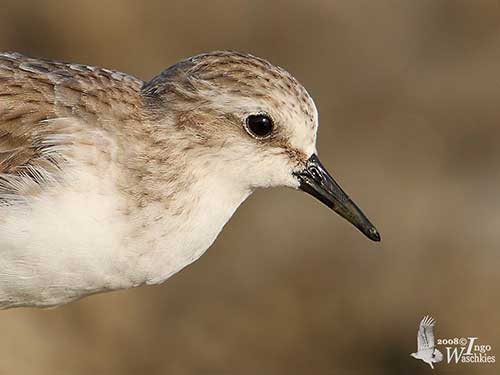
BEHAVIOUR IN THE WILD:
The Red-necked Stint feeds primarily on insects and crustaceans. During the breeding season, it feeds mainly on insects such as flies (adults and larvae). Outside this period and on migration, it feeds on a wide variety of crustaceans found in shallow water and mud, and it also takes insects, small molluscs and worms.
It forages by walking on shores and in shallow water, with a rather hunched posture. It picks rapidly at the muddy surface while searching for tiny items. It may also probe in the mud with the bill.
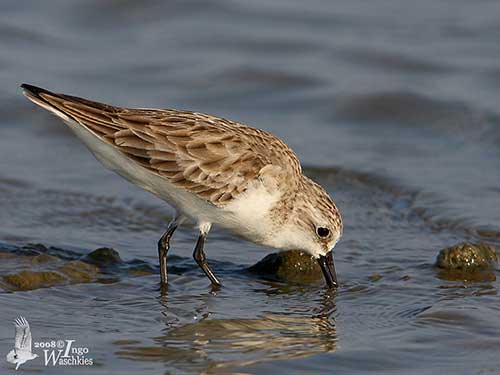
During the breeding season, the male performs aerial displays over the territory, by fluttering and gliding while uttering a repeated nasal call. At the end of this display, the wings are held in a V high over the back, and the bird drops to the ground.
This species is monogamous and nests on the ground.
The Red-necked Stint is highly migratory and the adults usually migrate S earlier than juveniles. They often migrate during July, using several stopovers along the coasts, whereas the birds crossing the Pacific use islands as stopovers. Some Siberian birds also move overland. The population breeding in Alaska moves through Aleutian and Pribilof Islands and joins the Siberian population. Immature birds often remain in the non-breeding range during the first year, and move to the inland wetlands after the rains.
The Red-necked Stint has swift, direct flight with rapid wingbeats. They usually migrate in large flocks.
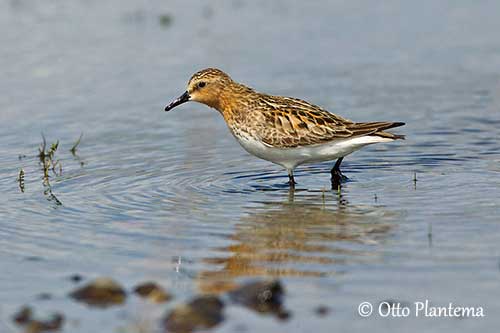
REPRODUCTION OF THIS SPECIES:
The laying occurs in June. The Red-necked Stint is monogamous and breeds in small, loose groups of 4-6 to 28 pairs/km².
The nest is a shallow depression, often on moss hummock in the rocky tundra. The nest is typically lined with willow leaves coming from the nearby dwarf willows.
The female lays 3-4 olive-buff eggs with brown markings. Both parents incubate during about three weeks. The downy chicks leave the nest soon after hatching and are probably able to feed themselves. They are often tended by the male alone, because the female may leave soon after hatching. The young fledge 16-17 days after hatching. This species produces a single brood, but replacement clutch occurs if the previous is lost.
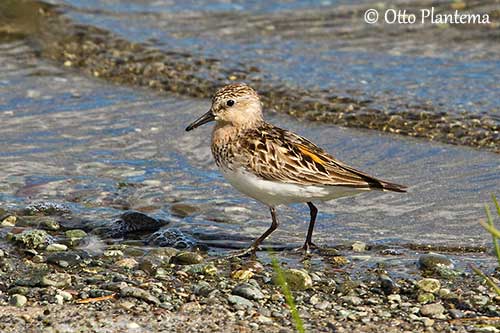
PROTECTION / THREATS / STATUS:
The Red-necked Stint is affected by habitat loss at stopovers in the Yellow Sea involving decline of the population. The intertidal areas are disappearing rapidly for agriculture expansion, aquaculture and various other human developments. In W Australia, numerous birds died due to pesticides.
The species is locally common on the breeding range but it is declining in the non-breeding areas. In addition, it is undoubtedly affected by changes in the East Asian-Australasian Flyway.
The global population was estimated at 315,000 individuals in 2002-2007.
The Red-necked Stint is currently classified as Near Threatened.
